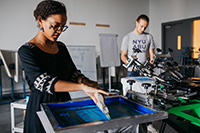-
Academics
-
Admissions
 Your journey to NYUAD starts here. Attend an application workshop or information session.Admissions Events
Your journey to NYUAD starts here. Attend an application workshop or information session.Admissions Events -
Research
-
Campus Life
 Live the possibilities. Be part of a dynamic community of students from over 115 countries.Take a Tour
Live the possibilities. Be part of a dynamic community of students from over 115 countries.Take a Tour - Public Programs
-
About
Exceptional education. World class research. Community-driven.Our Story
- News
- Events
- Social Media Directory
- Press Room
-
- Torch at NYUAD
- Faculty
- Current Students
- Alumni
- عربي
Events
Visible Certainty Conference
April 23-24, 2024
Since the launch of Sputnik in 1957, space exploration has soared, resulting in thousands of satellites orbiting our planet. However, with SpaceX planning to launch an additional 42,000 satellites, space is becoming increasingly congested. Forty experts convened at the Visible Certainty symposium to deliberate on how to ensure the safety and sustainability of space, while also preserving dark skies for astronomers. Panel discussions explored topics such as the potential benefits of mega-constellations for scientific research, the importance of dark and quiet skies, the necessity for international regulations, and the challenges posed by space junk and debris, as well as the UAE's activities in space. Distinguished guests, including the US Deputy Chief of Mission in the UAE, Eric Gaudiosi, the Italian Ambassador, Lorenzo Fanara, and His Excellency Ibrahim Al Qasim, Deputy Director General of the UAE Space Agency, honored us with their presence. The symposium proved to be a fruitful dialogue aimed at shaping the future of space exploration for all.
The Conference was convened by Simonetta Di Pippo and Andrea V. Macciò. More information may be found at the conference website.
Variable Sources in Galaxies Workshop
February 6 and 7, 2024
The Center produced the first Variable Sources in Galaxies Workshop where research presentations were given on the topic of time-resolved observations of objects in galaxies that vary. Galaxies are relatively stable structures over millions (but possibly not billions) of years. However, galaxies are teeming with erratically variable sources. This zoo of flickering, pulsating, dipping, flaring and oscillating objects provide a wealth of information about exotic objects in our galaxy and others. In this workshop, many of these variable sources were discussed.
The Scientific Organizing Committee was spearheaded by Professor Dave Russell, along with Joseph Gelfand, Andrea Macció, and Ingyin Zaw. The workshop poster may be found here.
Careers in Space
CASS Director, Professor Andrea V. Macciò moderated a talk called Careers in Space on November 29, 2023. He was joined by UAE astronaut Hazzaa AlMansoori alongside crew members from NASA's Expedition 69, Frank Rubio (NASA), Stephen Bowen (NASA), and Andrey Fedyaev (Roscosmos). They discussed their individual career highlights and engaged with students and the NYUAD community.
Workshops and Key Seminars
Future Directions in Solar, Stellar and Planetary Physics
Date: January 21-23, 2020
Future Directions in Heliophysics
Date: January 16-18, 2018

/events/11-29-2023-careers-in-space/11-29-2023-careers_in_space.jpg.transform/gallery-thumbnail/image.jpg)
/events/11-29-2023-careers-in-space/11-29-2023-careers_in_space-4.jpg.transform/gallery-thumbnail/image.jpg)
/events/11-29-2023-careers-in-space/11-29-2023-careers_in_space-5.jpg.transform/gallery-thumbnail/image.jpg)
/events/11-29-2023-careers-in-space/11-29-2023-careers_in_space-2.jpg.transform/gallery-thumbnail/image.jpg)
/events/11-29-2023-careers-in-space/11-29-2023-careers_in_space-3.jpg.transform/gallery-thumbnail/image.jpg)























